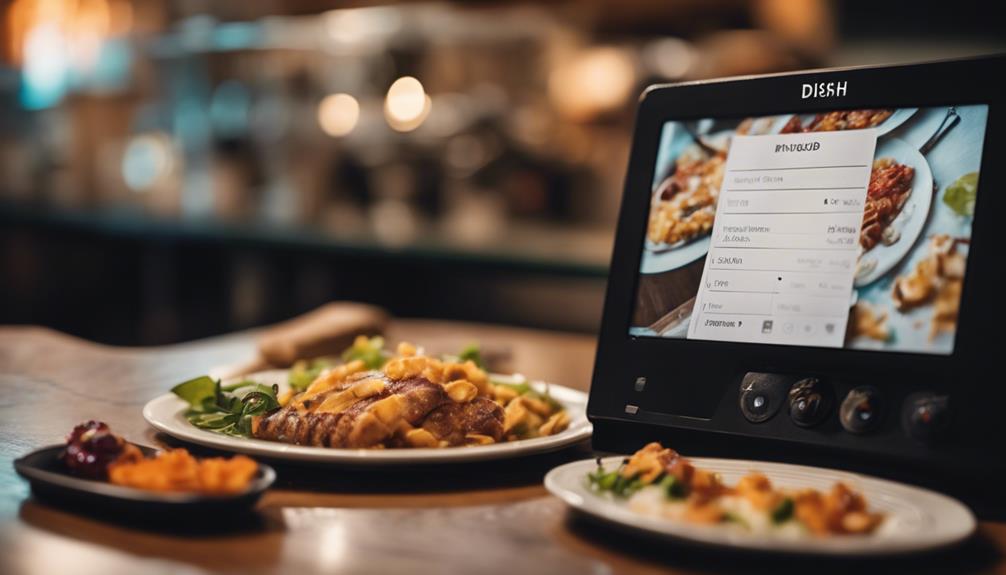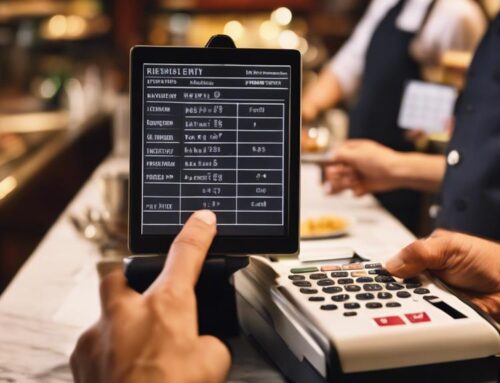When entering restaurant menu data, ensure to include item name, accurate descriptions, prices, categories, allergens, nutritional details, and availability updates. This meticulous approach guarantees precise, thorough, and customer-friendly data organization. For more insights on optimizing menu data entry, explore further details provided.
Item Name
When entering data for restaurant menus, ensure that each item name is accurately spelled and clearly descriptive to facilitate customer understanding and ordering efficiency. The item presentation plays a crucial role in attracting customers and increasing sales. Make sure that the item names are not only correct but also appealing and enticing. Consider incorporating customer feedback and preferences into the item names to resonate with the target audience.
Menu design is essential for showcasing the items effectively. By having well-crafted item names, you can enhance the overall menu design and create a cohesive dining experience for your customers. Additionally, consider incorporating seasonal offerings into the item names to keep the menu fresh and exciting for returning customers.
Description
To provide customers with a comprehensive understanding of each menu item and enhance their ordering experience, ensuring detailed and enticing descriptions is key. When crafting descriptions for your restaurant menu, consider the following crucial points:
- Clarity: Clearly describe the dish, its components, and any special preparation methods to avoid confusion or disappointment.
- Tempting Language: Use enticing words that evoke the senses and create a desire to try the dish, enhancing the overall customer experience.
- Storytelling: Share the inspiration behind the dish, its cultural significance, or any interesting facts to engage customers and make the menu more memorable.
- Alignment with Menu Design: Ensure that the tone and style of the descriptions align with your menu design and overall branding strategy, providing a cohesive experience for diners.
Price
When setting prices for your restaurant menu, it’s crucial to consider cost implications and your overall pricing strategy. Understanding the cost of ingredients, preparation, and overhead expenses is essential in determining the optimal price points for your dishes. By carefully analyzing these factors, you can develop a pricing strategy that aligns with your business goals and appeals to your target customers.
Cost Considerations
Considering your restaurant menu’s cost is essential for ensuring profitability and customer satisfaction. When focusing on cost considerations, it’s crucial to pay attention to various aspects. Here are some key points to keep in mind:
- Profit Margins: Understanding your costs helps in setting prices that ensure healthy profit margins.
- Budgeting: Proper cost analysis aids in effective budgeting and financial planning.
- Pricing Analysis: Conduct regular pricing analysis to adjust menu prices based on cost fluctuations.
- Cost Management: Efficient cost management practices can help in reducing expenses and maximizing profitability.
Pricing Strategy
Understanding your restaurant’s pricing strategy is vital for setting competitive prices that maximize profitability and customer satisfaction. Conducting a thorough market analysis and comparison with competitors can help you determine appropriate pricing levels. Analyzing your costs, target market, and desired profit margins will aid in establishing a pricing structure that aligns with your business goals. Consider the customer perception of your prices and ensure they match the value proposition you offer. By finding the right balance between pricing and perceived value, you can attract customers while maintaining a profitable operation. Regularly review and adjust your pricing strategy based on market trends and customer feedback to stay competitive and meet the evolving demands of your clientele.
Category
When organizing your restaurant menu data, carefully assigning categories to each item is crucial for a well-structured menu. Categorizing menu items correctly helps customers easily navigate through the options and find what they are looking for. Additionally, a well-defined category system can aid in analyzing sales data and making strategic pricing decisions.
Menu Organization Tips
To enhance the efficiency of your restaurant’s menu data entry, carefully structuring the categories is paramount for easy navigation and management. When organizing your menu, consider these tips:
- Use Section Headers: Divide your menu into clear sections such as appetizers, entrees, desserts, etc., for a more organized layout.
- Optimize Menu Layout: Arrange items logically within each section to make it easier for customers to find what they are looking for quickly.
- Maintain Consistency: Ensure a consistent format for displaying prices, descriptions, and item names throughout the menu.
- Include Specials Section: Create a separate section for daily specials or seasonal dishes to highlight them effectively.
Item Description Details
For effective menu data entry, meticulously craft detailed descriptions for each item to provide customers with a clear understanding of the offerings. When describing items, include information on ingredient sourcing to highlight freshness and quality. Detailing flavor profiles helps customers envision the taste experience, enticing their palates. Mentioning portion sizes guides customers in managing their hunger expectations. Additionally, noting any dietary restrictions met by the dish ensures those with specific needs can easily identify suitable options. By attentively addressing these aspects in your item descriptions, you enhance the overall dining experience for your patrons, setting clear expectations and showcasing the thoughtfulness put into your menu offerings.
Pricing and Specials
Crafting precise pricing details and showcasing enticing specials on your menu elevates the dining experience for your customers, guiding their choices with clarity and enhancing their overall satisfaction. When entering pricing and specials into your restaurant menu data, make sure to include:
- Happy Hour Deals: Highlighting special discounted prices during specific hours can attract customers during quieter times.
- Seasonal Promotions: Incorporating seasonal specials keeps your menu fresh and encourages customers to try new items.
- Daily Specials: Offering unique dishes each day can create excitement and entice repeat visits.
- Discount Options: Providing discounts for seniors, students, or loyal customers can increase customer loyalty and attract new clientele.
Allergens
Understanding and accurately labeling allergens is crucial for ensuring the safety of your customers and complying with regulations in the restaurant industry. Allergen management is a critical aspect of food service, as some customers may have severe allergic reactions to certain ingredients. By providing clear information on allergens present in your dishes, you demonstrate a commitment to customer safety. Ingredient transparency is key, not only for customers with known allergies but also for those with specific dietary restrictions. Including allergen information on your menu helps customers make informed choices about what they consume, fostering trust and loyalty.
When inputting menu data, be meticulous in listing all potential allergens present in each dish. Common allergens include peanuts, tree nuts, dairy, eggs, gluten, soy, and shellfish. Accurate allergen labeling can prevent cross-contamination and allergic reactions, safeguarding your customers’ well-being. Remember, even small traces of allergens can have severe consequences for individuals with allergies. Prioritize clarity and precision in your menu data entry to uphold the highest standards of food safety and customer care.
Nutritional Information
When managing nutritional information for your restaurant menu, precision in detailing the calorie counts and macronutrient content of each dish is paramount. Ensuring accuracy in this data not only helps customers make informed choices but also caters to those with specific dietary restrictions. Here are essential points to consider when dealing with nutritional information:
- Calorie Count: Provide the exact number of calories in each dish to assist patrons in tracking their daily intake accurately.
- Macronutrient Content: Detail the amount of protein, fats, and carbohydrates present in the meal for customers with specific health goals.
- Ingredient Sourcing: Mention the origin of key ingredients to address concerns related to sustainability, quality, and allergens.
- Health Claims: Include any pertinent health claims associated with the dish, such as being gluten-free or rich in antioxidants, to appeal to health-conscious diners.
Availability
To ensure a seamless dining experience, it is essential to maintain accurate and up-to-date information regarding the availability of dishes on your restaurant menu. Keeping track of daily specials and seasonal availability allows customers to make informed choices based on what is freshly prepared or in line with the current season. Weekly promotions can attract patrons looking for deals, so ensuring that these are always updated on the menu can drive sales and customer satisfaction. Additionally, noting limited quantities of certain dishes can create a sense of urgency and exclusivity, prompting customers to try them before they run out.
Frequently Asked Questions
How Can Restaurants Ensure the Accuracy of Their Menu Data Entry?
To ensure accuracy in menu data entry, you must prioritize data validation. Double-check all entries, cross-reference prices, and verify descriptions. Consistency is key; maintain a meticulous approach to avoid errors and provide accurate information to your customers.
Is It Important for Restaurants to Update Their Menu Data Regularly? if So, How Often Should They Do So?
You should prioritize data maintenance by updating your menu regularly based on customer feedback and market trends. Timing of updates varies but aim for at least quarterly revisions to keep your offerings current and enticing.
What Are Some Common Challenges Faced by Restaurants During Menu Data Entry and How Can They Overcome Them?
Feeling overwhelmed by menu data entry challenges? Make sure to focus on data verification to avoid errors. Train staff for efficiency. Organize your menu meticulously. Consider using software solutions for smoother processes.
Are There Any Legal Requirements or Regulations That Restaurants Need to Consider When Entering Menu Data?
When entering menu data, remember compliance requirements and industry standards. Ensure data security and address privacy concerns. Stay informed about any legal regulations that apply to your restaurant’s menu data entry processes to avoid potential issues.
How Can Restaurants Use Menu Data Entry to Enhance the Overall Customer Experience and Increase Sales?
Rev up your sales by tailoring menus to customer feedback. Play with pricing strategies and menu customization to wow patrons. Consider dietary restrictions for a top-notch experience that boosts your bottom line.




